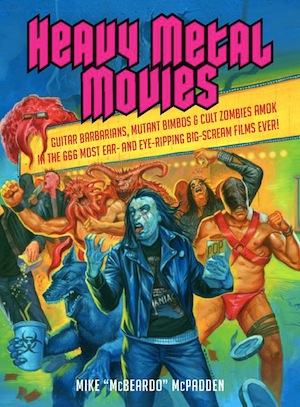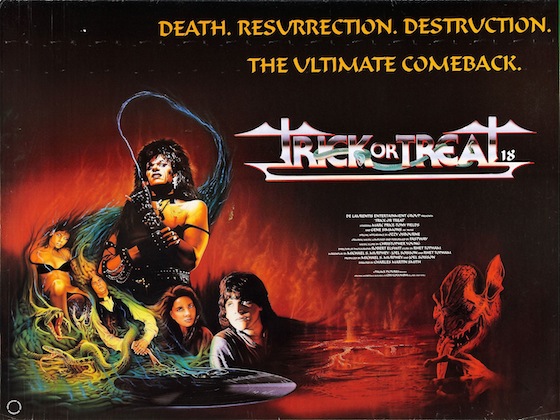 Mike McPadden might not be a name familiar to many, but if you’re a fan of naked famous ladies, you’ve likely read his writing. McPadden has been the head writer for celebrity nudity site Mr. Skin for well over a decade now. Additionally, his website McBeardo has been a haven for strange, b-movie schlock reviews and stories for years. However, after a lifetime of freelance writing, McPadden has put together the likely culmination of all those diverse interests. His new book, Heavy Metal Movies: Guitar Barbarians, Mutant Bimbos & Cult Zombies Amok in the 666 Most Ear- and Eye-Ripping Big-Scream Films Ever! is out today from Bazillion Points, and based on what we’ve been able to read thus far, it’s a doozy. If you enjoyed the “punks in film” book Destroy All Movies!, you’re going to need this. We spoke with McPadden by phone about the book and his movie-watching habits.
Mike McPadden might not be a name familiar to many, but if you’re a fan of naked famous ladies, you’ve likely read his writing. McPadden has been the head writer for celebrity nudity site Mr. Skin for well over a decade now. Additionally, his website McBeardo has been a haven for strange, b-movie schlock reviews and stories for years. However, after a lifetime of freelance writing, McPadden has put together the likely culmination of all those diverse interests. His new book, Heavy Metal Movies: Guitar Barbarians, Mutant Bimbos & Cult Zombies Amok in the 666 Most Ear- and Eye-Ripping Big-Scream Films Ever! is out today from Bazillion Points, and based on what we’ve been able to read thus far, it’s a doozy. If you enjoyed the “punks in film” book Destroy All Movies!, you’re going to need this. We spoke with McPadden by phone about the book and his movie-watching habits.
Scene-Stealers: So, you’ve put together this epic book, and it seems like the putting together was pretty epic, as well.
Mike McPadden: It was. I have worked on Heavy Metal Movies – the book – every day for three and a half years.
How many hours a day were you putting into this?
It’s actually an interesting question. I had kind of a technique. I work a very time-consuming day job, but I was sort of able to mesh it all together. During the week, I would watch movies and take notes, here and there, so that was anywhere from 3-6 hours a day. Then, Friday through Sunday, I would gather the notes, and churn out these reviews. And those were like, epic 8, 10, 12, 16-hour days.
 And your day job also involves movies, to an extent.
And your day job also involves movies, to an extent.
Yeah. I’ve been head writer at Mr. Skin for 11 years.
That’s an awful lot of movies.
Yes. I’ve been very inert for the last 3 years. I just started going back to the gym and it’s been extremely painful.
In terms of the subject matter of the book, “heavy metal movies” seems like a pretty wide-open description.
Yeah, and so the trick to it was to say that these are the “most metal,” and I am your guide as to what consists the “most metal.” You’re either going to like what I say or not – probably both, at times – but it came down to isolating the metal gene in all of the movies I had not seen, and of the ones I had not yet seen. Many, I had not seen.
So, the analogy I use is that you look at a chihuahua and a Great Dane and somehow know that they’re both dogs is similar to the way you can listen to Sabbath, Poison, Slipknot and Bathory and somehow know it’s all heavy metal. The idea was to say, whatever that gene is, whatever that mysterious factor is, it also exists in movies, so let me go out and try to find the 666 best examples. And, when I say, “best,” I mean “most evident” examples of that mystery metal factor.
It seems that there are some themes – a lot of horror movies, for example. What I really noticed, though, is that there are quite a few movies that predate the idea of heavy metal.
Right. It goes back to Thomas Edison’s Frankenstein, which is from 1910, and then Häxan, which is from the ’20s, which is the history of witchcraft, and that is the black, bubbling ooze from which Sabbath – and subsequently, the rest of metal – emerged. In cases such as that, like Noseferatu, the vampire himself, in terms of t-shirts, album imagery, flyers, tattoos … there was metal before metal, and those movies are good examples of them.
Following the process on the Heavy Metal Movies Facebook page, it seemed like you were discovering new movies almost daily. What was that process like? Would one movie just lead you to another, with people recommending things?
Well, that was the fun and the curse, at the same time. I knew probably 300-400 movies, just being a professional movie fanatic. Off the top of my head, I came up with several hundred examples I could fit into the book. In cracking those open, the director might be connected to ten other movies that might make it, or this guy starred in that, and just like, watching TV, and there’d be a weird sequence set to a metal song.
The social media aspect of it – first of all, the book is dedicated to a guy named Danny Peary, who wrote a series of books called Cult Movies in the ’80s, which forever changed my life, in addition to guys like Michael Weldon, who did The Psychotronic Encyclopedia of Film. I bow down permanently, and give hosannas to, anyone who wrote a reference book before the Internet. I don’t know how it was possible, especially those big, broad, sweeping books like that.
‘Cause I would just go online and go, “I’m looking for a copy of Paganini Horror,” which is one of the last really weird discoveries. It’s just a 1989 movie about the classical composer Paganini, who has come back from the dead to torment a rock ‘n’ roll band that has come to record in his castle. I cam across the poster or something while looking for other images. But, I could go online and say, “Paganini Horror: who’s got a copy? Who can point me in the right direction?”
The audience was really crucial in helping me write this book, so I thank each and every one of you and them that are out there.
I know the original number of films was supposed to be 666, but I also know it’s gone double that. What’s the official final count?
We won’t know until the book is officially printer, but I know that I wrote more than 1300 reviews, and my guess is that about 900 made the book. There are hundreds upon hundreds out there, floating around, that will turn up online, or hopefully in a volume two, if we can sell enough.
It was insane, because I would just keep finding them or be in touch with Ian Christie, who’s the maven of Bazillion Points – who’s just the most amazing talent, the most amazing editor. He designed the book, and it looks incredible – and I’d be like, “We have to include this,” and he’d be like, “Hell, yeah, we have to!” Nobody, I mean nobody’s knowledge of metal rivals Ian’s. He wrote the definitive history of heavy metal, called Sound of the Beast.
Toward the end, I’d be like, “I’m getting’ close. I’m getting’ close,” and he’d be like, “Here’s 16 DVD-length features on these band’s concerts videos and you have to review them for the book.” It was daunting, but it was great, so that guy was not just helpful, but indispensable to creating this book.
Regarding concert films and biographic movies, what was your criteria for including them or just not looking at them at all?
That’s where it becomes a tricky line. Basically, if I believed it could have played in a theater and attracted a paying audience. For example, down. put out a concert video a few years ago on video, and they shot it with real 35mm cameras, and it looks like a ’70s concert film – that’s a perfect example of something that belongs in the book.
But there at least a dozen Iron Maiden documentaries. That was another thing, because Maiden, to Ian, is like the Ramones to me growing up in new York in the ’70s. So, Ian would just send me 20 Iron Maiden movies in these e-mails that I cherished and dreaded at the same time, because it was like, so huge. But a band like Maiden, that puts out four concert films a year, it seems – I can’t review all of them. That’s why the “most metal” gets in there.
But, certainly, Flight 666, which is the documentary of their tour where Bruce Dickinson was the pilot of Ed Force 1, their private jet – I actually did see that in the theater here in Chicago, so that was a cool experience I got to use in the book early on. So, that’s it: if I felt it could play in a theater in the ’70s – or now – it counted.
What were the movies that you started with, and were like, “oh, yeah, of course”? Something like Trick or Treat?
Yes. Prior to this: the genesis of this book began in 2009, [when] my friend Eric Danville edited a book called The Official Heavy Metal Book of Lists, and I contributed two chapters to that book. One was “The 13 Greatest Heavy Metal Horror Movies,” and that was all Trick or Treat, Rocktober Blood, Black Roses, Hard Rock Zombies: the real ’80s, metalsploitation, cash-in horror films, which – across the board – are pretty great. I’d say there’s not really an unentertaining one in that bunch.
Then, I followed that with “The 13 Most Metal Moments in Non-Metal Movies.” And that was stuff like Twisted Sister filming a music video for “Burn In Hell” in Pee-Wee’s Big Adventure, and Marty McFly melting his father’s brain with Van Halen in Back to the Future, stuff like that.
So, right there, I had a really solid core of 26 movies, and we spun it out from there. Those are the obvious ones. And then, the stuff that obviously and culturally embodies metal culture. So you have Conan the Barbarian, Mad Max, Blade Runner – sword and sorcery movies, post-apocalyptic sci-fi. The big ones of those provided a really strong, 100-title base from which the rest of the book could spin out.
This is a lame question to conclude on, but what was the movie you saw in the course of writing Heavy Metal Movies that impacted you the most – the one that made you sit up and say, “how have I never seen this before?”
I love that movie!
Yeah, and I saw it when it first came out. I’m a horror fan, and I left the movie going, “That was cool – there are little homunculi running around, that’s cool,” but re-watching it now, I was like, “This should be a pre-teen, rock and roll classic,” and I’m really hoping that this book will shine more light on that film, because I think that is a really good gateway (pun intended) for kids into the world of horror movies and heavy metal. Darker, scarier stuff, they can handle when they get older, but it is a fun, scary, amazing-looking movie, which I would always use as an example of why CGI is lame and why puppets are cool.






Comments on this entry are closed.